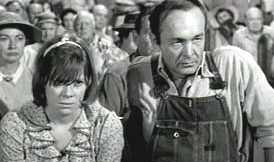To Kill a Mockingbird: Discrimination Against Race, Gender, and Class

Harper Lee’s classic novel To Kill a Mockingbird centers on a young girl named Jean Louise “Scout” Finch. Her father Atticus Fincher, a lawyer, takes a case to defend a black man accused of raping a white woman.
Nelle Harper Lee was born on April 28, 1926 in Monroeville, Alabama. Lee drew inspiration from her own childhood: like Scout, Lee’s father was also a lawyer. Although the novel is not autobiographical, the novel does share some similarities to Lee’s life. While the novel is set in the 1930s, the novel does touch upon issues relevant to Lee’s time. According to an interview, Lee took about two years to write To Kill a Mockingbird (The Bluegrass Special). Prior to the novel’s publication, the Civil Rights movements was in motion. During this decade, the Civil Rights Movement brought success, seeing “the first major victories for civil rights in the Supreme Court” (Vox). Among the many events, including Brown vs. Board of Education, the Montgomery Bus Boycott, a protest that later concluded in declaring segregated laws of Montgomery and Alabama buses as unconstitutional, and after a group of nine African American students were denied entry to Little Rock High School, President Eisenhower sent federal troops to integrate the school. In addition, since the novel is set in the 1930s, the Great Depression left many families impoverished, which we see in the Cunninghams and Ewells.
The novel is told from Scout’s perspective; through Scout, we the readers witness the social construction of race, class, and gender. The novel continues to be taught in classrooms due to its depiction of themes about race, morality, and innocence. While the novel depicts a discrimination against race, To Kill a Mockingbird also depicts a discrimination against gender and class.
Race
In the novel, Scout and Jem, Scout’s older brother, are looked after by Calpurnia, their black housekeeper. Although Scout shares her differences with Calpurnia, Calpurnia serves as a mother-figure for the children. She’s revered and respected by Atticus, who acknowledges that Calpurnia is educated. Yet, it is speech that separates the black community from the white. When Scout and Jem attend Calpurnia’s church, Scout notes that Calpurnia adopts a different speech when she communicates with her fellow churchgoers: “That Calpurnia led a modest double life never dawned on me. The idea that she had a separate existence outside our household was a novel one, to say nothing of her having command of two languages” (143). Although Scout and Jem struggle with the idea that Calpurnia speaks two different languages, Scout respects Calpurnia for mastering both languages since she asks to visit Calpurnia at her home.

The trial of Tom Robinson serves as the pivotal and highly-anticipated moment in the novel. Tom Robinson is accused of raping a young white woman named Mayella Ewell. The Ewell family lack education and money, representing the lower class. As the oldest child, Mayella becomes a mother figure for her younger siblings. In addition, the novel implies that Mayella is involved in an incestuous relationship with her father. While Atticus represents justice and morality, Bob Ewell represents ignorance and racial prejudice. After all, Bob Ewell’s full name is Robert E. Lee Ewell, named after the general who commanded the Confederate army. The name plays a significant role considering the Confederate army represented southern slave states and their right to expand slavery, thereby reinforcing Bob Ewell’s racism.

For Tom Robinson, we quickly learn that he is convicted based purely on the color of his skin. Earlier in the novel, Scout relates that Atticus views the Ewell family as “the disgrace of Maycomb” (33). However, because the Ewells are a white family, they hold a higher social status. During the trial, it is implied that Mayella seduces Tom Robinson, and her father, Bob Ewell, observes in horror that his daughter would share intimate feelings for a black man. In addition, Bob Ewell’s reaction to his daughter kissing Tom Robinson shows the fear of miscegenation. Atticus, however, strives for justice. Atticus explains the ugly truth to Jem and Scout: “In our courts, when it’s a white man’s word against a black man’s, the white man always wins” (251-252). Atticus shows disgust with white people taking advantage of a black person’s ignorance” (252). Furthermore, Atticus makes it clear to his children that racism exists:
“As you grow older, you’ll see white men cheat black men every day of your life, but let me tell you something and don’t you forget it—whenever a white man does that to a black man, no matter who he is, how rich he is, or how fine a family he comes from, that white man is trash” (252).
Gender
Along with race, Lee discusses gender throughout her novel. Having lost her mother at an early age, Scout does not fret over her lack of femininity; however, her Aunt Alexandra does not approve of her unladylike behavior. While Atticus shows indifference towards Scout’s tomboy-ish behavior, Aunt Alexandra makes it her mission to decimate Scout’s tomboy tendencies.
Scout shares resentment towards being called a “girl,” always taking the word as an insult. Because Aunt Alexandra is staying for a given amount of time, Scout, to her dismay, realizes she must follow her aunt’s rules. “I felt the starched walls of a pink cotton penitentiary closing in on me, and for the second time in my life I thought of running away. Immediately” (155). The preceding quote expresses Scout’s feeling and attitude towards femininity. By describing femininity as a penitentiary suggests that girlhood is like a prison that keeps her captive, suffocating her.

At one point in the novel, Aunt Alexandra hosts her Missionary Society meeting; one of the women, Mrs. Grace Merriweather, expresses concern regarding the Mrunas, an African tribe. While this moment is brief, the discussion shows the hypocrisy of these women: the ladies of the Missionary Society pity the Mrunas, yet they do not share the same compassion towards the African American community in their own town. At first, Scout helps Calpurnia serve the ladies, but Aunt Alexandra interjects and tells Scout to sit with them, which Scout remarks is “part of her campaign to teach me be a lady” (262).
After the jury convicts Tom Robinson, Jem is distraught and wonders why good people, “like us and Miss Maudie,” the Finches nearby neighbor, don’t “serve the jury” (252). Atticus explains that Miss Maudie cannot serve because she is a woman; since the jury consisted of men, this reveals gender discrimination. Like the African American community, the women in Maycomb suffer from inequality.
Class
On the first day of school, Scout clashes with her teacher Miss Caroline. During lunchtime, Miss Caroline offers money to one of her students, Walter Cunningham. When Walter refuses the money, Scout explains to Miss Caroline that the Cunninghams suffer from poverty. Scout narrates a time when Atticus served as the Cunningham’s lawyer, and having no money to repay Atticus, the Cunninghams pay Atticus in the form of stovewood and hickory nuts.
Later in the story, Jem invites Walter to their house for lunch. While eating their meal, Walter pours molasses “on his vegetables and meat with a generous hand” (27). This act not only causes Scout to remark and embarrass Walter, but also shows a difference in status between the Cunninghams and the Finches.
After lunch, Scout returns to her class and notices Miss Caroline “standing in the middle of the room, sheer horror flooding her face” (28). The scandal reveals itself: a boy known as Burris Ewell has lice, or more specifically “cooties.” While Miss Caroline is sickened by Burris’s hygiene, the rest of the class does not seem perturbed. In fact, one of the students, Little Chuck, states “There ain’t no need to fear, a cootie, ma’am. Ain’t you ever seen one? …you just go back to your desk and teach us some more” (28). Scout observes Burris, describing his physical characteristics: “his neck was dark gray, the backs of his hands were rusty, and his fingernails were black deep into the quick” (29). Burris Ewell’s physical description reveals his low status and poor living condition. The Ewells, however, share similarities with the African-American community: they lack education and money. Although the Ewells lack education and money, they hold a higher elevation because they are white.

Winner of the Pulitzer Prize, To Kill a Mockingbird allows readers to witness the racial tensions in the South. In 1962, the novel was adapted into a feature-length film, starring Gregory Peck as Atticus. After the novel’s publication, Lee retreated from the spotlight. In recent news, however, an unpublished manuscript surfaced as the sequel to To Kill a Mockingbird, leaving many rejoicing or protesting against the publication. Whether the planned sequel is published or not, we can agree that To Kill a Mockingbird will continue to stand the test of time. The novel is rich, dealing with themes about racism and presenting an unjust world. Lee’s novel depicting the injustices in race, gender, and class is a call to take action, telling her readers to embrace change that benefits others and pursue justice and equality.
Work Cited
Lee,Harper. To Kill a Mockingbird. New York: Harper Perennial Modern Classics, 2006. Print.
“To Kill a Mockingbird turns 50.” The Bluegrass Special. Feature, 2009. Web.
Vox, Lisa. “Timeline of the Civil Rights Movement, 1951-1959.”About.com. About Education, n.d. Web.
What do you think? Leave a comment.











A fantastic article, you show your knowledge of To Kill A Mockingbird with great depth.
You know what’s weird? When I first read this at age twelve, I hated Jem. I remember liking the book, and when everyone talked about how it was the American novel of the century, I thought to myself, “But how could you like a novel where one of the protagonists is more irritating than an eyelash stuck in your contact lens?”
I love how Lee puts the confounded confusions of adulthood into simple thinking when viewed through the eyes of a child.
I find it kind of boring. It’s not really going anywhere, and it seems like some parts of the book are random and have nothing to do with the rest of the story.
The characters are so real. Even when you hate them, no one in this book is one-dimensional.
It’s a classic book for good reason.
I liked the feel of being able to look through a child’s eye and see their naive and innocent look of the world. It makes you think about what you would do being in their shoes and you realize they wouldn’t know what the right or wrong was, until being told.
I think it is incredibly difficult to capture the imagination of a child. The author has done so flawlessly. I found myself growing up with Scout.
Well done! This is such a thorough analysis I love it!
I cannot count the numerous times I constantly found myself laughing out loud, gasping in shock or smiling to myself whilst reading this book.
Possibly one of the most perfect books ever written. I feel like if there were a checklist for everything a great novel should be, this would get a perfect score.
I am certain I read this book at some point previously in my life, but on my recent vacation to sublime Nicaragua, I decided to take a copy with me. What a revelation!
I just can’t get over how funny it is.
watch the movie PLEASANTVILLE after reading this novel.
Conger
You get such a sense of place from Lee’s masterful descriptions.
This is a truly amazing book. The writing and story telling are amazing and the characters bring the story to life.
A wonderful book, a true classic. This book says a lot about the nature of good and evil in the everyday man.
this book has told me in a few passages what years and years couldn’t possibly have..the simplicity,and honesty of this novel is exquisitely beautiful.
/ananya
So many great characters and subtle lines that make you think. I guess I should have read this in English class way back when.
Good article, with an acute analysis of the key themes in the book. I was definitely intrigued by Atticus’s character and how he himself seems to have no class, gender or race prejudice – his sensitivity and awareness is commendable and also in itself breaks gender preconceptions.
I recently watched the movie version for a film course discussing racism in hollywood; I definitely need to read the novel again.
An impressive and touching book that I didn’t want to put down unless I absolutely had to.
A great overview of three of the novels most compelling themes!
One of a kind and my all time favorite ever!
Great article to read, as we await the sequel!
Parts of the book were uncomfortable to read, but it was a good example of the people were treated back then. And I like this article.
I read Mockingbird for the first time when I was seven years old. It was a tough read for one so young and I certainly didn’t recognize the themes that Harper Lee laid out in the novel, but I identified with the character of Scout – I was a tomboy with an older brother with whom I fought but who was often times my protector. I saw the film some years later and it was at that time that I began to grasp the tenets of this simple, yet beautifully written story. Race, gender and class discrimination are all thoroughly examined in this novel and the author of this article has revealed them in detail with the most exemplary examples from the text. Growing up in the South, I was surrounded by race, gender, and class bias. Those who live there, or who have lived there for any amount of time, know that things change slowly in that neck of the woods. Although my childhood began after the Civil Rights Movement started and was roughly thirty to forty years after the setting of the novel, discrimination still remained, and remains to this day, a part of everyday life there, as it does in many areas of the country. I read Mockingbird every few years and learn something new from it with each reading. Until I was an adult, I didn’t realize the statement it made regarding mental health, which is not touched on in this article but I believe is another extremely important message in this book. When I see Mockingbird on high school required reading lists, particularly in the South, I am hopeful – hopeful that the Atticus Finches out there begin to outnumber those who would value a person based on the color of his/her skin or the diminished capacity of his/her mind. I saw Robert Duvall at a restaurant last week and I had to stifle the urge to go up to him and say, “Hey, Boo.”
A great analysis on a great novel. Really displays the harsh reality of the world.
Classic. All classics come with the notion that you either love it or hate it.
The inconvenient reality of society depicted with great finesse. I look forward to reading ‘To Set a Watchman’.
first lol
who ever wrote this is a big fagot. nah I’m just joking with you
that you forgot the URL address
I would like to read it..where I can get a free copy?
I would’ve liked it if I had chosen to read it in my own accord… I read it in school and it sucked.
When writing an essay on women discrimination, writers should look at the history. Their argument should be based on verifiable statistics. The information should be discussed in the concept of social economic consequences. Discrimination against women is one of the major societal problems over time now. It has brought major impact learning, domestic life, and community institutions as well. This challenge has been an issue globally. There has been a perception that women belong to certain professions for example; in nursing, teaching, and secretarial work.
This was beautifully written and it really helped me write my paper!!
This is great! Thank you for writing this!
who is the author of this article To Kill a Mockingbird: Discrimination Against Race, Gender, and Class
I love my life.
I really love my life.
Guys need help with this question; demonstrate how does bias and prejudice in ”To kill the mocking bird does frastrate philosophical investigation?
excuse you, the quotes you pulled aren’t even on those page numbers: I’m not even sure if they’re in the book! You didn’t use TKAM to do your research and I hope you burn in hell
god damn
pee is stored in the balls
yes it is
the artikle was gut, but rassism is bad. LG
stop cappin
A good essay on a memorable book and movie.
This is a primer on To Kill a Mockingbird. It would have been nice, however to cover the Radleys.